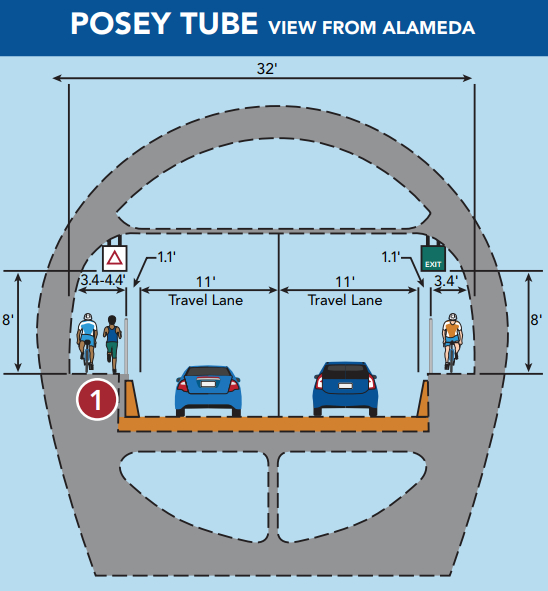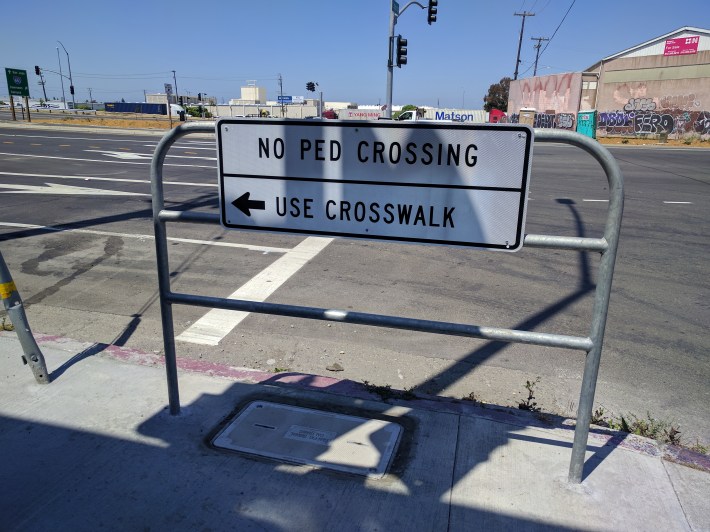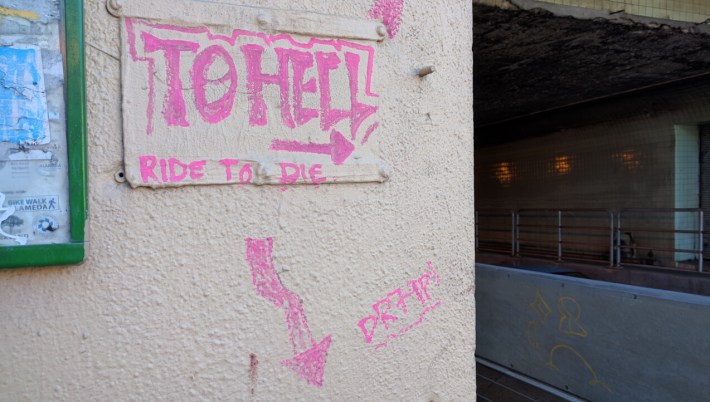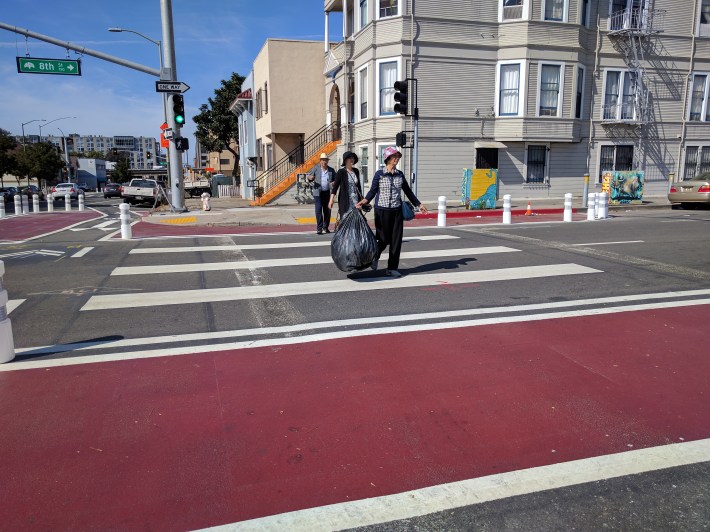Editorial: Stop Caltrans and Alameda County from Creating Another Pedestrian Hellscape
4:17 PM PDT on July 22, 2019

Don’t worry cyclists, we’re going to let you bike on both sides of the tunnel to hell. Image: Alameda County Transportation
Note: GJEL Accident Attorneys regularly sponsors coverage on Streetsblog San Francisco and Streetsblog California. Unless noted in the story, GJEL Accident Attorneys is not consulted for the content or editorial direction of the sponsored content.
The Oakland Alameda Access Project (OAAP) is an $83 million project, run by the Alameda County Transportation Commission (ACTC), its HTNB consultants, and Caltrans that, if designed right, could help heal the gash created between Chinatown and Oakland's waterfront by the Nimitz Freeway. Unfortunately, it is being run by retrograde traffic engineers who are only concerned with increasing car throughput.
Going by the latest plans, it is proceeding just like the last collaboration of the ACTC and Caltrans, the 23rd and 29th Street Oakland overpasses between Jingletown and Fruitvale, over the Nimtz freeway. In that case, they didn't even build sidewalks on both sides of the bridges and basically banned walking through major parts of the projects (see image below). They striped the drainage pans and called them bike lanes, and then congratulated themselves on a "commitment to improving local communities" and providing "...new ways to connect, commute and commune that don’t require the use of a personal automobile."

The OAAP is following the same Orwellian pattern.
The ACTC and Caltrans team says it wants to address the "lack of pedestrian and bicycle connectivity" between Chinatown and Jack London Square. But, as with 23rd and 29th, they will remove crosswalks and sidewalk, this time at the intersections of Jackson and 5th and 6th Street. They plan to add landscaping to "discourage illegal pedestrian crossings" so people walking don't interfere with the ramp they want to add from the tunnel to the freeway to increase car throughput to and from Western Alameda and its car-centric new developments.
They do plan to add a few disjointed bike lanes and other sops for cyclists, including a new ramp to the Posey Tube's 3.4-foot maintenance catwalk/bike lane, which is currently the only way for a cyclist or pedestrian to get between Oakland and Western Alameda.
In fact, the lead image, taken directly from OAAP documents, pretty much says it all if you want to understand the degree to which the planners on this project don't understand (or just don't care about) bicycle and pedestrian safety.
No sane person jogs in the Posey tube. And nobody in their right mind would bike in it either, except that many cyclists simply have no choice. The traffic noise in the tunnel is as loud as a jet engine; the air is so dirty that if you wear a white t-shit it will be visibly sooty by the time you pass through; and the catwalks are so narrow that two cyclists can't even pass each other, let alone ride alongside a jogger. It's barely wide enough for a single bike's handlebars.
Caltrans is under intense pressure from lawmakers to get with the program on complete streets, so they have to do something. In this case, the team assigned to this project promises to open the second catwalk on the opposite side of the tube, which is currently closed. It's an obvious sop, but, in fairness, I suppose it will allow cyclists to choke to death or risk a fall on both sides of the tube.

The planning team going through the motions of their legally required "community outreach" says it has conducted meetings with many groups, including my own homeowners association. My HOA President, Brendon Levitt, is a very smart, progressive architect who rides his bike to his office in Eastern Alameda. After over a year of fruitless, frustrating meetings and "updated" plans "to address stakeholder concerns" that don't actually contain any changes, he wrote the following to the project team about their plans and a letter they sent to him (and me) earlier this month:
We are in receipt of the "updated" plans but were disappointed to see the degree to which our concerns were dismissed. In your letter you write, "as a result of your feedback," in an attempt to make it appear as if our comments were considered. However, the actual design continues to ignore our feedback, including pedestrian and bicyclist safety, activation of the city streets, activation of the underpasses, traffic calming, lighting, and vegetation.
...It's clear that automobile throughput is the project's priority. This comes at the expense of basic principles of urban design, let alone our health, safety, or community.
Some are sold on this project because it also involves tearing down the Broadway off-ramp, since that space will be needed to create the new ramp connecting the tunnels to the freeway. If properly implemented, that could help restore some of Chinatown's street grid and keep some freeway-bound traffic off local streets.
But the OAAP team also wants to widen the Oak Street off-ramp to ensure that just as many cars continue to flow into Oakland at high speeds, just on a slightly different alignment, and at ground level instead of above grade. They refuse to even add a protected bike lane to 6th Street, which would become the defacto off-ramp, because it would "require the removal of parking spaces," explained Dina Potter, a consultant on the project, during one of their outreach meetings. The painful irony is that the parking spaces that she's refusing to give up on 6th don't even exist yet, since that's currently the location of the aerial Broadway off-ramp.
She added that people need their parking and "cyclists need to compromise."
Either way, we don't have to tear down the ramp to improve streets in Oakland's Chinatown. Oakland's Department of Transportation, which recently installed protected bike intersections around Lake Merritt's BART station, have shown how, for pennies on the dollar, they can make make Chinatown's streets far more pedestrian friendly and safe:

And if they want to improve the area right where the ramp is located, well, there are lots of places, even as close as Rockridge and San Francisco, where we've seen that these spaces under freeways and ramps don't have to be filled exclusively with trash, parking lots, and muck. In fact, a project to light and activate the space under the freeway at Jack London Square continues to languish, thanks in large part to the recalcitrance of Caltrans.
Bike and safety advocates from Bike Walk Alameda and Bike East Bay, meanwhile, are working hard to eke out minor bike improvements on this project. But at some point we need to move beyond sops and minor improvements. We already have a giant freeway, wide, car-centric streets, massive inequities, and an epidemic of road violence. The time for compromise and "balancing needs" is over.
"The OAAP had a great opportunity to heal some of the wounds caused by the Nimitz Freeway," wrote Levitt, in his email to the project team. "Instead, ACTC seeks to reinforce those problems, setting Oakland back in its attempts to create a vibrant city while encouraging Alameda's dependence on the car."
If Alameda County and Caltrans want to build a worthwhile project, they already know what to do: spend the $83 million on a bike and pedestrian lift bridge between Jack London Square and Western Alameda, finally giving residents of Western Alameda a reasonable way to walk, scooter, and bike to BART and downtown Oakland. There'd be plenty of money left over to clean up Caltran's muck-covered undercrossings, activate and light the spaces under the freeway (and the Broadway off-ramp), and add protected bike lanes and intersections and other pedestrian improvements between Jack London Square, Chinatown, and downtown Oakland. That's how they can actually achieve the stated goals of the OAAC project and connect these communities.
But the current team is never going to push for that. And that's why the project needs to be cancelled--or at least rebooted, with a completely different group of planners and consultants and different lead agencies. Because it's screamingly obvious that the people who created the lead image don't know a thing about walking or biking, let alone Oakland, Alameda, or access.
Stay in touch
Sign up for our free newsletter
More from Streetsblog San Francisco
Weekend Roundup: Bancroft Lane Gets Concrete, Party in Downtown S.F.
...and the Bay Bridge to get its lights back
Richmond-San Rafael Bridge Bike Lane Will Need Support
There's no evidence the bike lane contributes to congestion on the bridge
Update on Oakland DOT’s Lakeshore Protected Bike Lane Project
Public seems fairly positive and accepting towards the coming project. Let's hope it stays that way




